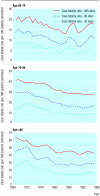Time trends and demography of mortality after fractured neck of femur in an English population, 1968-98: database study
- PMID: 14525871
- PMCID: PMC214070
- DOI: 10.1136/bmj.327.7418.771
Time trends and demography of mortality after fractured neck of femur in an English population, 1968-98: database study
Abstract
Objectives: To investigate time trends in mortality after admission to hospital for fractured neck of femur from 1968 to 1998, and to report on the effects of demographic factors on mortality.
Design: Analysis of hospital inpatient statistics for fractured neck of femur, incorporating linkage to death certificates.
Setting: Four counties in southern England.
Subjects: 32 590 people aged 65 years or over admitted to hospital with fractured neck of femur between 1968 and 1998.
Main outcome measures: Case fatality rates at 30, 90, and 365 days after admission, and standardised mortality ratios at monthly intervals up to one year after admission.
Results: Case fatality rates declined between the 1960s and the early 1980s, but there was no appreciable fall thereafter. They increased sharply with increasing age: for example, fatality rates at 30 days in 1984-98 increased from 4% in men aged 64-69 years to 31% in those aged > or = 90. They were higher in men than women, and in social classes IV and V than in classes I and II. In the first month after fracture, standardised mortality ratios in women were 16 times higher, and those in men 12 times higher, than mortality in the same age group in the general population.
Conclusions: The high mortality rates, and the fact that they have not fallen over the past 20 years, reinforce the need for measures to prevent osteoporosis and falls and their consequences in elderly people. Whether post-fracture mortality has fallen to an irreducible minimum, or whether further decline is possible, is unclear.
Figures



References
-
- Boyce WJ, Vessey MP. Rising incidence of fracture of the proximal femur. Lancet 1985;8421: 150-1. - PubMed
-
- Kannus P, Niemi S, Parkkari J, Palvanen M, Vuori I, Jarvinen M. Hip fractures in Finland between 1970 and 1997 and predictions for the future. Lancet 1999;353: 802-5. - PubMed
-
- Falch JA, Kaastad TS, Bohler G, Espeland J, Sundsvold OJ. Secular increase and geographical differences in hip fracture incidence in Norway. Bone 1993;14: 643-5. - PubMed
-
- Lau EM. Admission rates for hip fracture in Australia in the last decade: the New South Wales scene in a world perspective. Med J Aust 1993;158: 604-6. - PubMed
Publication types
MeSH terms
LinkOut - more resources
Full Text Sources
Medical
Miscellaneous
